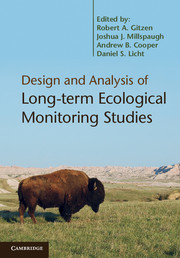Book contents
- Frontmatter
- Contents
- List of contributors
- Foreword: Ecology, management, and monitoring
- Preface
- Acknowledgments
- Abbreviations
- Section I Overview
- 1 Ecological monitoring
- 2 An overview of statistical considerations in long-term monitoring
- 3 Monitoring that matters
- 4 Maximizing the utility of monitoring to the adaptive management of natural resources
- Section II Survey design
- Section III Data analysis
- Section IV Advanced issues and applications
- Section V Conclusion
- References
- Index
- Plate Section
3 - Monitoring that matters
Published online by Cambridge University Press: 05 July 2012
- Frontmatter
- Contents
- List of contributors
- Foreword: Ecology, management, and monitoring
- Preface
- Acknowledgments
- Abbreviations
- Section I Overview
- 1 Ecological monitoring
- 2 An overview of statistical considerations in long-term monitoring
- 3 Monitoring that matters
- 4 Maximizing the utility of monitoring to the adaptive management of natural resources
- Section II Survey design
- Section III Data analysis
- Section IV Advanced issues and applications
- Section V Conclusion
- References
- Index
- Plate Section
Summary
Introduction
Monitoring is a critically important activity for assessing the status of a system, such as the health of an individual, the balance in one's checking account, profits and losses of a business, the economic activity of a nation, or the size of an animal population. Monitoring is especially vital for evaluating changes in the system associated with specific known impacts occurring to the system. It is also valuable for detecting unanticipated changes in the system and identifying plausible causes of such changes, all in time to take corrective action.
Before proceeding, we should define “monitoring.” One definition of “monitor” (Microsoft Corporation 2009) is “to check something at regular intervals in order to find out how it is progressing or developing.” The key point here is “at regular intervals,” suggesting a continuing process. Some definitions do not indicate the repetitive nature of monitoring and are basically synonymous with “observing.” Most monitoring, in the strict sense of the word, is intended to persist for long periods of time, perhaps indefinitely or permanently. Similarly, Thompson et al. (1998: 3) referred to the “repeated assessment of status” of something, but noted that the term “monitor” is sometimes used for analogous activities such as collecting baseline information or evaluating projects for either implementation or effectiveness. For their purposes, they restricted the term to involve repeated measurements collected at a specified frequency of time units. Let us adopt that definition, recognizing that repeated measurements imply collecting comparable information on each occasion.
- Type
- Chapter
- Information
- Publisher: Cambridge University PressPrint publication year: 2012
- 8
- Cited by

